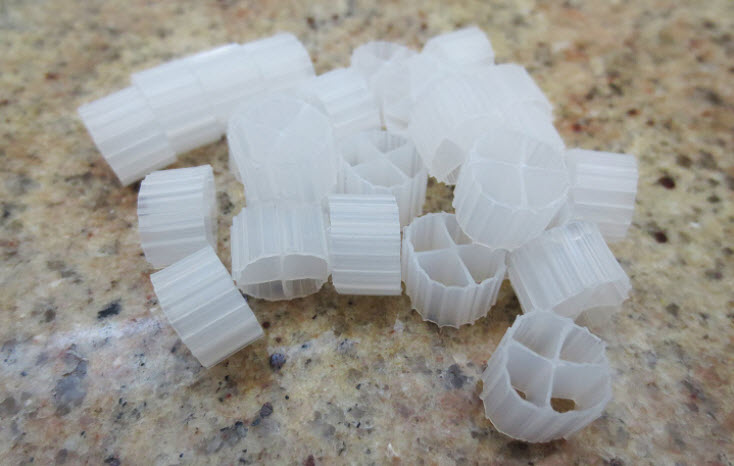
K1 is a chopped plastic media that is used both in something called a “fluidized bed sump” (or a “moving bed bioreactor” or MBBR) and used as a static (i.e. “stationary and unmoving”) media in other aquarium filters. The ability of fluidized K1 to biofilter the water and give crystal clear, very healthy water is simply the best of any media. K1 is the third best static biomedia to put in any aquarium filter, behind foam and only slightly behind pot scrubbers.
What is often missed is how cheap a fluidized bed can be IF AND ONLY IF the K1 can be purchased in bulk. On the basis of pounds of fish that can be well biofiltered, fluidized K1 is only 22% the cost of 30 ppi Poret foam. Indeed, even the stationary K1 is 46% the cost of 30 ppi foam on a per pound of fish biofiltered basis.
The static 30 ppi foam compares to the fluidized K1 as follows:
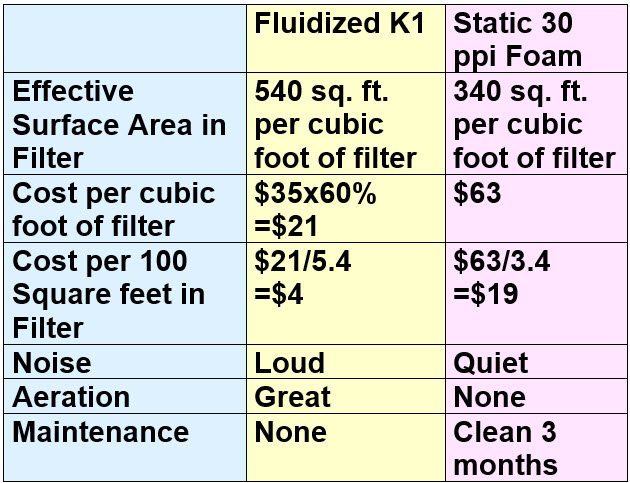
It is important to note that the K1 efficiency is per cubic foot of filter, NOT per cubic foot of K1 filter media. Big difference! Also note that most K1 media is sold in kilogram quantities and 1kg k1 media is 0,004m3. So an 80 liter fluidized bed at 60% loading requires 12 kilograms of K1 (0.080 m3 x 0.60)/0.004 m3 = 12
If one is a nerd like the author one might be interested in this long boring article on why K1 is such a good media. It includes testing which proves this is true.
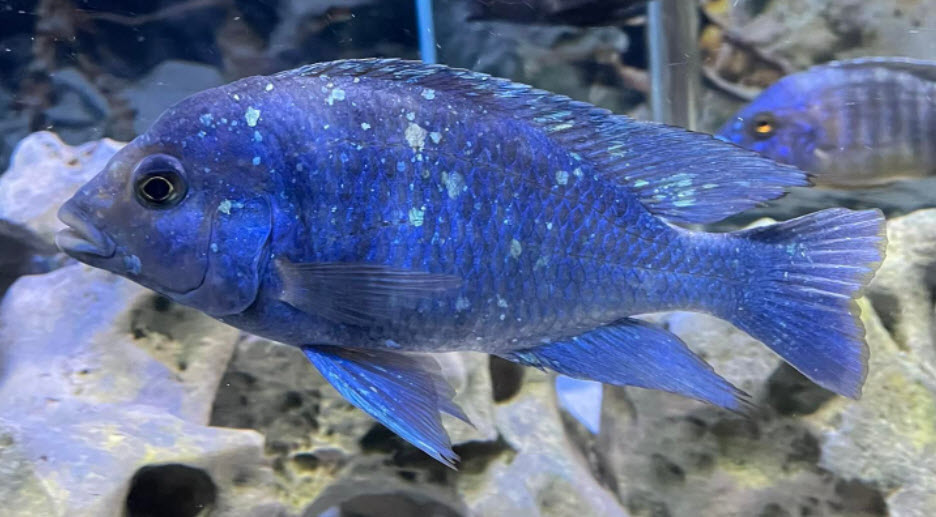
The surface area of the K1 should be very, very roughly about midway between the surface area of 30 ppi foam and the surface area of the 1/8 inch gravel.
There are small extruded and chopped plastic media which look like plastic slices of okra. The original design was the Kaldnes K1 design from Europe. This media has become known simply as “K1” media, even though there are now many different designs and copycats. Helix Floating Bio Media is virtually identical to K1 media. I simply work out the cost per cubic foot of media and buy the cheapest one I can find on the internet at bulk pricing. I buy a LOT of this at one time.
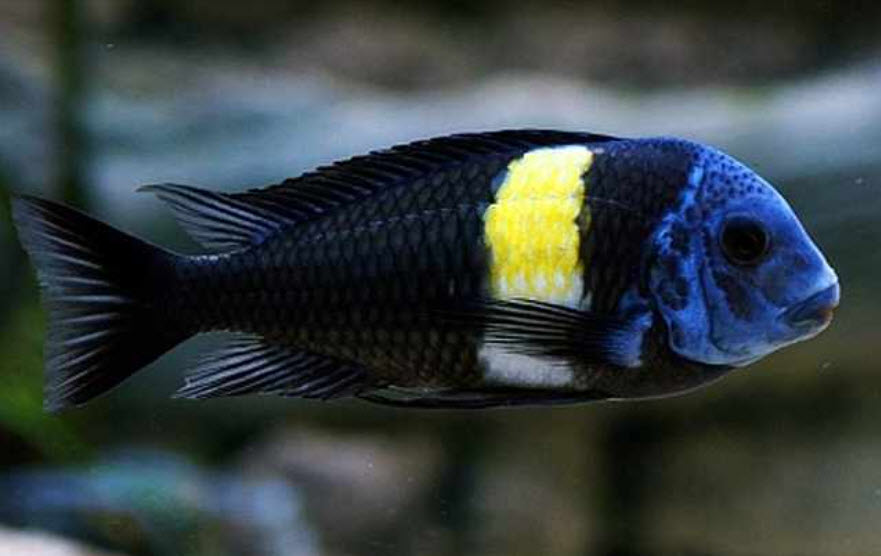
K1 and similar rip-offs are the only media that should be used in fluidized bed filters in home aquariums.
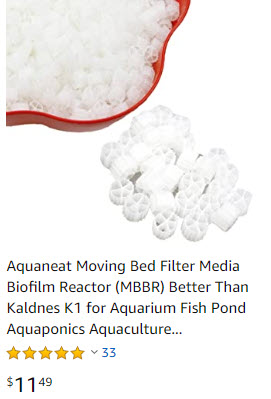
One gallon of media in bulk can be had for $11.49, which isn’t bad. Note that in aquarium media if you are buying K1, ceramic rings, or bioballs you must buy in bulk of at least one gallon. In smaller quantities the price is simply ridiculous. For instance, one liter of K1 is $21, which equates to $76 per gallon. With COVID the price of this media has more than doubled. But the price discounts for buying in quantity are still huge. It is now up to $13 to $25 if you buy one gallon, $55 if you buy one cubic foot (that is $7.33 per gallon). On EBay you can buy 2 cubic feet for $70. That is $4.67 per gallon, $1.24 per liter, or $35 per cubic foot when you buy in bulk of two cubic feet.
But the price is HUGELY variable at the current time. Some suppliers are selling at $13 per gallon, some are selling for $30 per gallon in quantities of a gallon. There is no way to predict where this price will go or even if you can get this media anymore (“supply chain problems”?). And it appears you cannot even get small quantities anymore, at ANY price. Also note that the price also varies a huge amount by country. In some countries it is very cheap and in others very expensive.
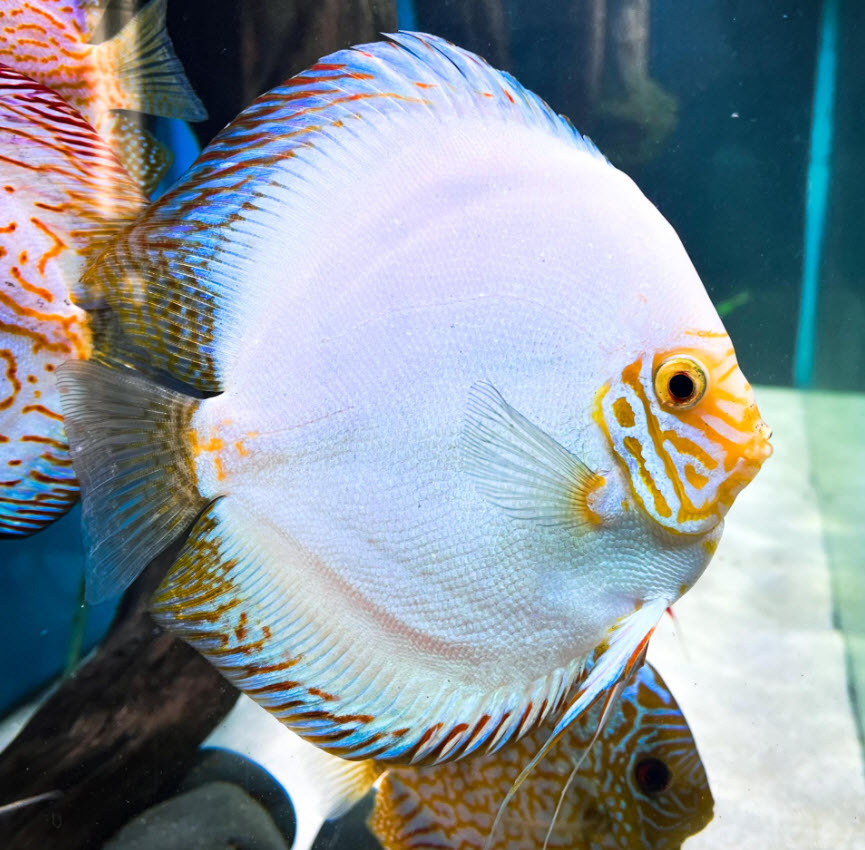
Note there are versions of “K1” called “micro”, “K2” and “K+”. These have smaller openings than straight K1. “Micro”, “K2” and “K+” have more surface area that straight K1. But they are shorter in channel length. And there are a large number of designs that can be found on the web. I have several different varieties of K1 rip-offs in my many K1 fluidized beds (I just buy the cheapest per cubic foot I can find when I need some) and they all seem to work very well.
One of the readers of this website used micro in one canister and regular K1 in another (i.e. a static media). The micro did fill completely with brown gunk in four months, which would considerably reduce its effectiveness. The regular K1 was still open. But this is for a static media. In a fluidized bed I have never had a K1 type media plug up, and I got a large assortment of types.
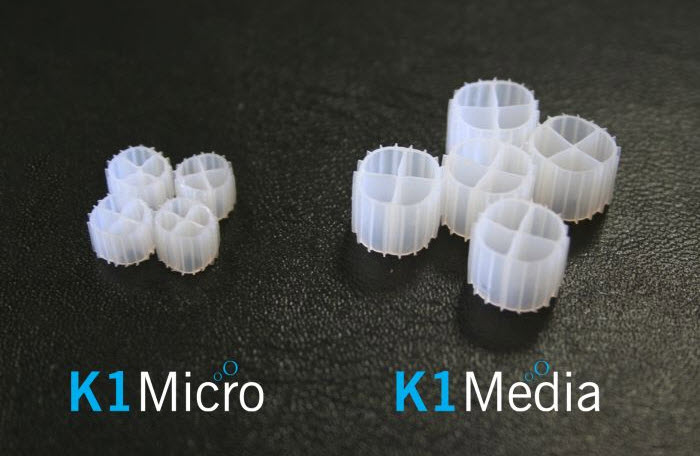
I’ve had K1 rip-off media go for three years in rapidly moving moving media beds with no cleaning and there is still daylight through each of the openings in the media. I.e. the media never “clogs”. Since clogging will reduce the efficiency of the K1 this is important.
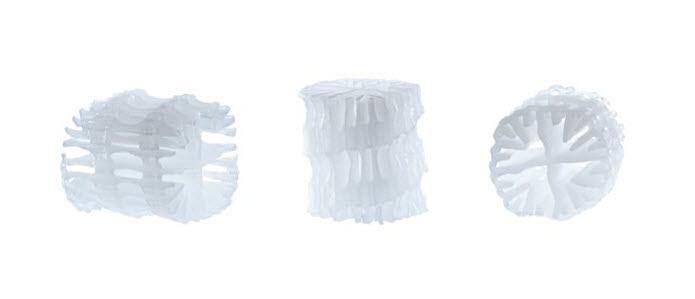
There is a similar product to K1 called “OASE Hel-X 13 BioMedia”. The OASE media looks like it will be equal to K1 media. I am a little concerned the OASE media openings inside are a little small, which means they may well plug in a few months. But I’ve never tested it so I can’t be sure.
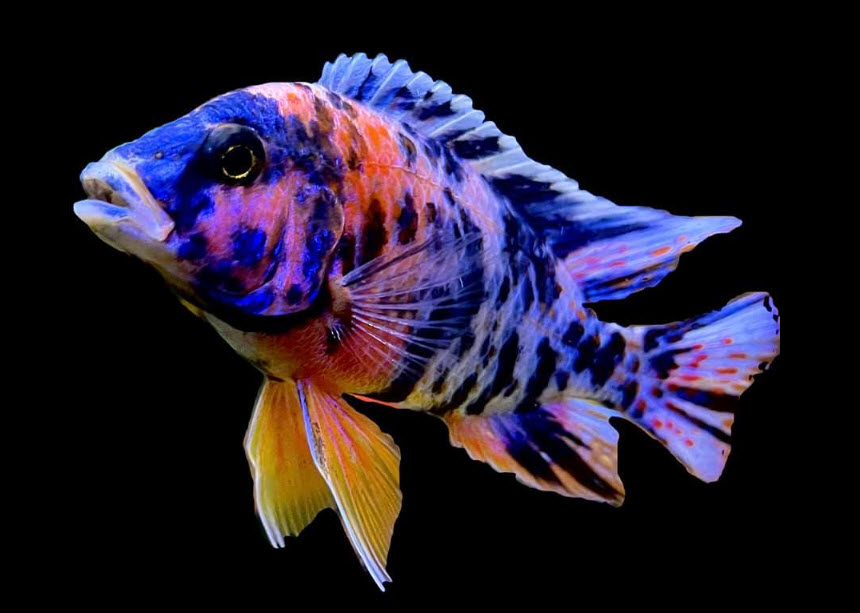
An exchange with one of the obsessive compulsive readers of this website went like this:
John
“Dave, I bought a bunch of what I thought was K1 media on Amazon. I made several purchases from several different places. I bought the 5-spoked version because I figured that must have more surface area. Now I have figured out that the 5-spoked version is smaller (is it “K2?”). All the 5-spoked versions I bought were the smaller size, even though they were labeled “K1” and sometimes claimed measurements the same as K1. I only figured it out when I bought some 4-spoked K1 and noticed the size difference.
Your K1 article has a picture of the 5-spoked version. The description from the manufacturer says “better than Kaldness K1.” I think that is actually one of the versions I bought, which turned out to be smaller than K1.
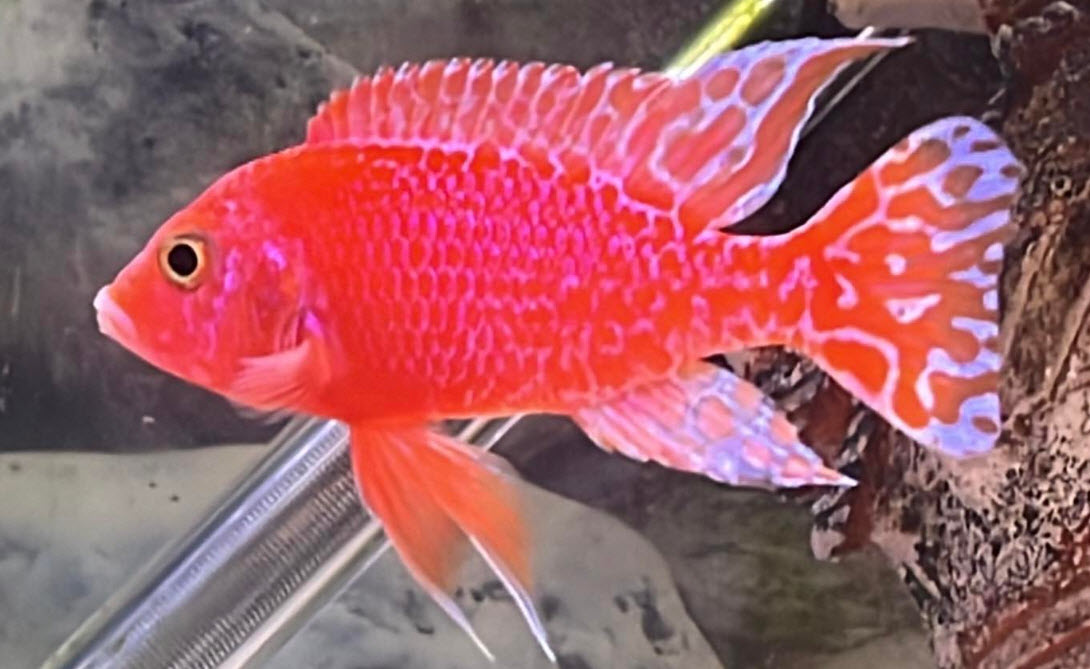
The sizes I could find represented on the internet were:
-
- the 4-spoked K1 is 12mm in diameter and 9mm high
- the 5-spoked (K2?) is 10mm in diameter and 7mm high [sometimes inaccurately described as 12mm x 9mm]
- the Micro is 7mm in diameter and 9mm high, according to evolutionaqua.com (where they sell Micro)
The 5-spoked media that I bought seems to be about the same diameter as the actual K1, but considerably shorter. What do you think of the 5-spoked media as compared to the 4-spoked K1 (12mm x 9mmH)? It would seem that the extra spoke would make it more likely to clog, but the shorter size would make it less likely to clog.”
Dave
“In reply to John … I don’t think there will be any noticeable difference. But I can confirm that the small openings do clog but ONLY in a static mode. There is no data or journal articles on it. I have done no formal testing. So I simply do not know for sure. But my anecdotal evidence is that ALL K1 type media performs the same in a fluidized bed”
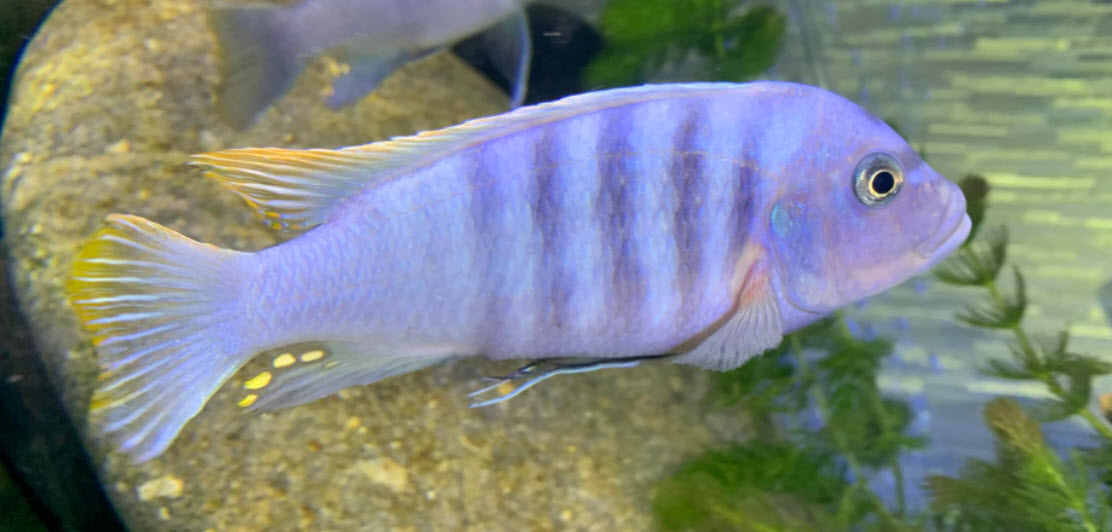
Static K1 Media
This K1 plastic media has a large surface area which is easily accessible to both bacterial growth and high water flows. This is a great combination for fluidized beds. What everyone is missing is that they are an excellent media for use in any type of submerged static media bed filter. They have one of the best combinations of price, ease of use and biofiltration area of any submerged static media.
The label for the K1 media quite correctly says:
- “Large protected surface area 950 m2/m3 (290 ft2/ft3)
- Can be used in Static or Moving Bed Filter Systems
- Ideal for use in External Aquarium Filters”
ALL the points on this label are 100% correct. This is very refreshing and is one of the few times I’ve seen 100% honesty from a supplier of aquarium products. The most important point here is:
.
Static K1 is a great media for canisters and no one knows it!
.
K1 can be put in the middle trays of all canisters. In the top tray of a bottom to top flow canister the K1 needs to be in a bag to keep it from floating out of the canister.
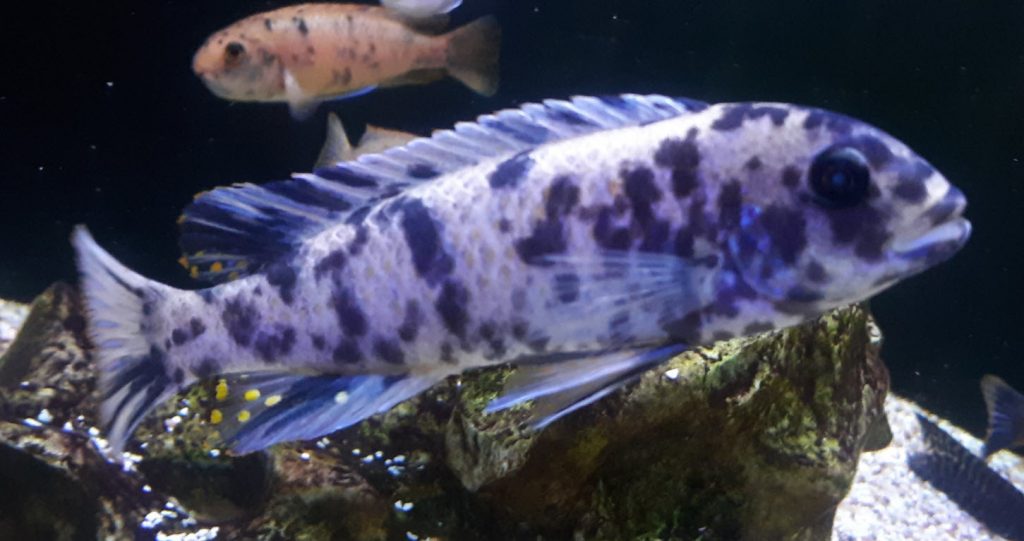
Testing Static K1
A test was run on all the various filter media in actual aquarium conditions. By this test K1 was exceeded only by foam and plastic pot scrubbers. It was five times better at ammonia oxidation that lava rock or ceramic rings.
A test of ammonia oxidizing capability of various filter media was run. The first number, the “efficiency” is the average ammonia oxidizing that 15 cubic inches of media accomplished over a 90-day period. The second number is the “effective” surface area in square feet per cubic feet calculated from that test. The third number is the effective surface area in square feet per cubic feet calculated by simple mathematics. The correlation between the test results and the calculated surface area is very significant and means the testing was accurate.
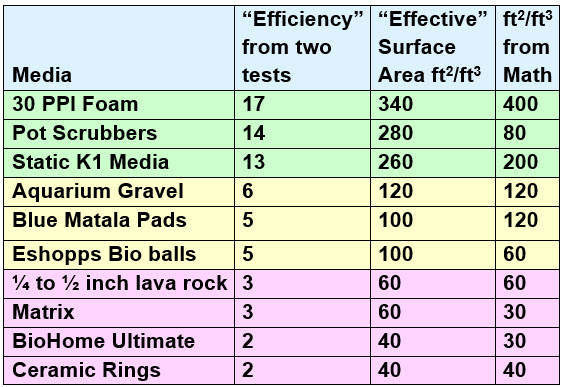
A series of extrapolations (i.e. “educated guesses”) was then made.
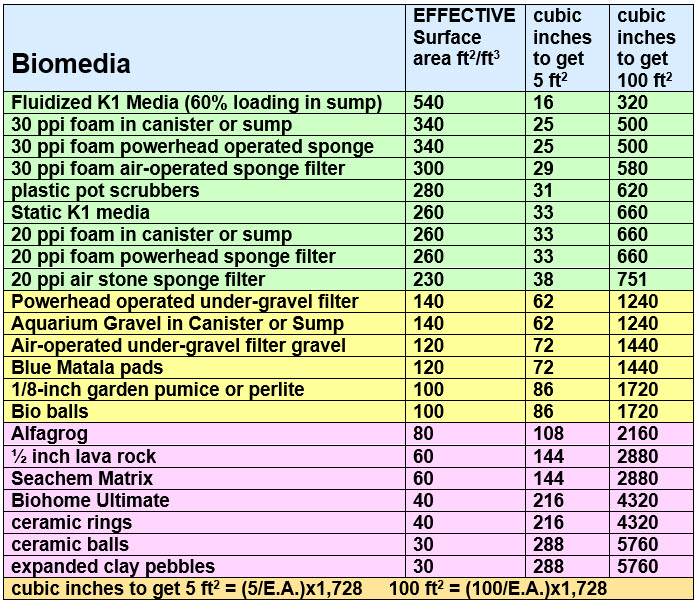
The higher the numbers here the better the media. Fluidized K1 is hands down the best media. Once again, it is important to note that the K1 efficiency is per cubic foot of filter, NOT per cubic foot of K1 filter media. It only takes 9.6 (16x 60%) cubic inches of actual K1 media to get five square feet of effective surface area in a fluidized bed.
Note people tend to obsess over these numbers and try to determine by exacting math exactly what will give them exactly 100 square feet per pound of fish and thus crystal clear water. This exactitude is not warranted. There are at least ten variables affecting this (aeration, water movement, feeding, pH, KH, food protein level, etc.) and they can react in very unpredictable ways. So these numbers are only VERY gross approximations.
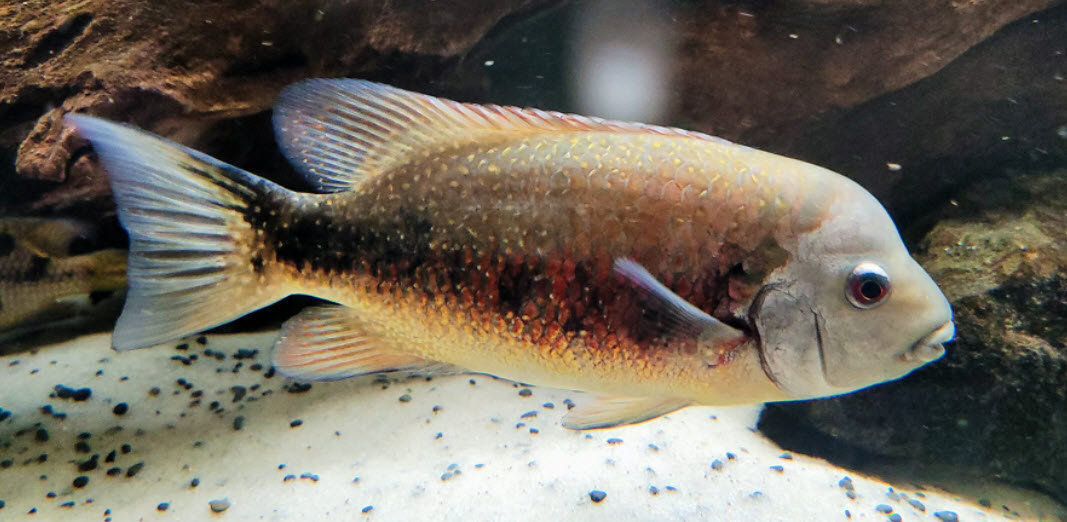
How Does Static K1 Stack Up?
A comparison is in order. This table compares K1 extruded plastic media to Matrix media as static biomedia in a canister filter or sump filter.
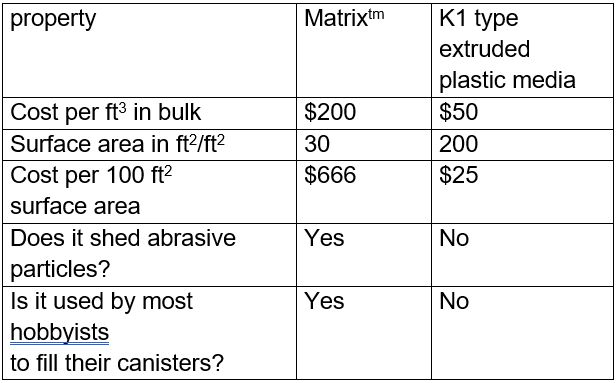
What this can translate to is illustrated by the number of fish a typical canister can handle stocked with these two media:
.
• Static K1 media – 20 five-inch fish
• Matrix – 3 five-inch fish
.
So Matrix costs four times more than K1 on a volume basis and a given volume of Matrix only can handle one sixth the load of a given volume of K1. This is a difference in cost effectiveness of a factor of 24, which is huge.
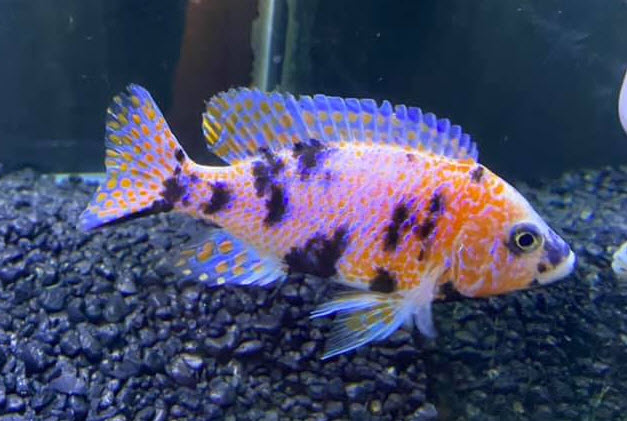
K1 in Fluidized Beds
The biggest use of K1 is in fluidized bed filters in sumps. The K1 media is loaded into the sump at about 60% of the available volume. Then the K1 is “fluidized” and kept in constant motion by the bubbles from air stones or wavemakers. Most advanced aquarists including the author are now using this type of filter quite successfully for any aquarium over 75 gallons.
This fluidized bed is simply the best filter that there is. In a fluidized bed filter the K1 has an effective surface area of roughly 540 square feet per cubic feet of filter volume. This is roughly twice the capacity of both 30 ppi foam and static K1 media.
Note there are some who say only to load the K1 media at 25% loading by volume of the sump. The 25% is based on the myth that it is the flow rate which determines the efficiency of the media. If you load 25% ALL the media and really pour the air to it, it is ALL constantly in movement. If you load 60% then about 25% is constantly in movement and some 35% of volume is stationary with water flowing through it.
This second scenario will give a much greater surface area for beneficial bacteria and will give much better filtration. Only the water needs to move for K1 to be effective. The seminal work on K1 media (“Advanced Compact Wastewater Treatment Based on Coagulation and Moving Bed Biofilm Processes”, Odegaard, 2000) says the “standard filling is 67%”.
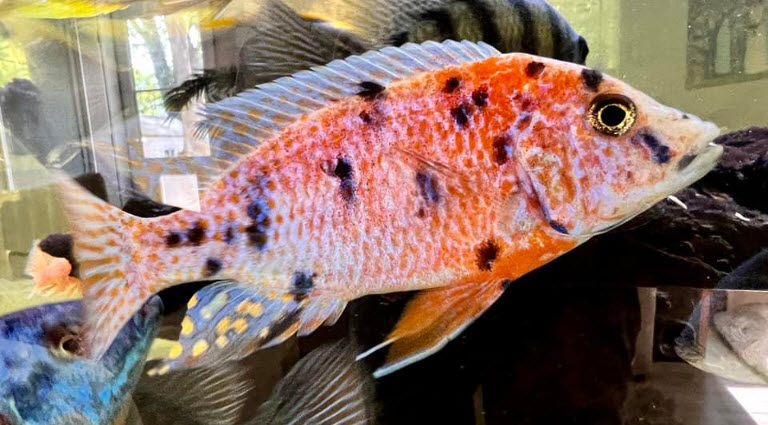
Other Fluidized Bed Media – Mutag Media
There is a type of media out of Germany called the “Mutag Biochip” which is a polyethylene foam disc. It probably (I haven’t tested it) will work about as well as K1 in a fluidized bed but it is somewhat difficult to keep in motion without it stacking up and stopping biofiltration. It can be made to work very well in commercial operation where there is constant engineering support. We do not feel that it is good for an aquarium fluidized bed. Note it cannot work in a static bed because of the tendency of the disks to stack with one another, like the chips in a box of Pringles.
Note also that, like most commercial media, the surface area claims for this product are just plain old marketing hype. They say they have 5500 m2/m3 (1,679 ft2/ft3)
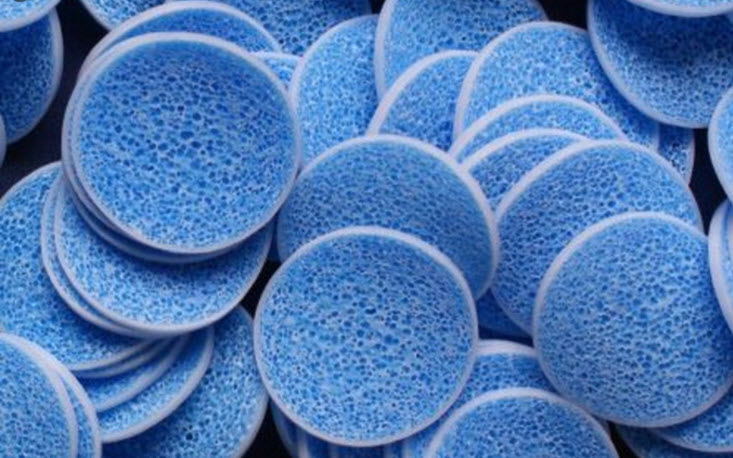
Fluidized bed Media – Foam Products
There are several types of foam media which are made both for fluidized beds and for static filter beds. They are typically one inch cubes or “X”s of about 30 ppi foam. Poret®aqua Cubes are one brand.
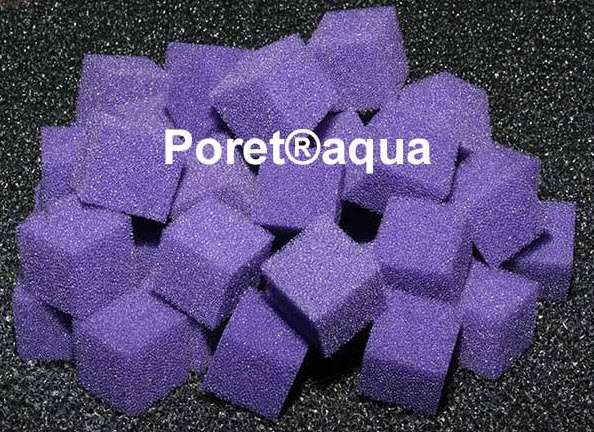
These typically come from Germany. They simply won’t work for a variety of reasons.
First off there is no flow though the urethane foam when it is in the water. The pores in this foam are too small. They will resist the flow of water through them far too much to be effective. Water will always take the path of least resistance.
The second not so obvious reason is than urethane has a specific gravity of 1.2. This means that when these foam pieces become waterlogged after a few weeks of operation they will simply fall to the bottom of the tank and stay there in a sodden useless mass. The material K1 is made of, polyethylene, has a specific gravity of 0.95, which means it floats forever and thus performs quite well as a fluidized bed media.
A reader has used both the Poret Aqua-media foam cubes and the K1 media in fluidized bed sumps. The cubes tended to not circulate, absorbing air and floating if the sump is air driven and absorbing water and sinking if the sump is powerhead driven. They also did not perform near as well as the K1 media as far as biofiltration, with a noticeable degradation in water clarity with the cubes. This was completely predictable.
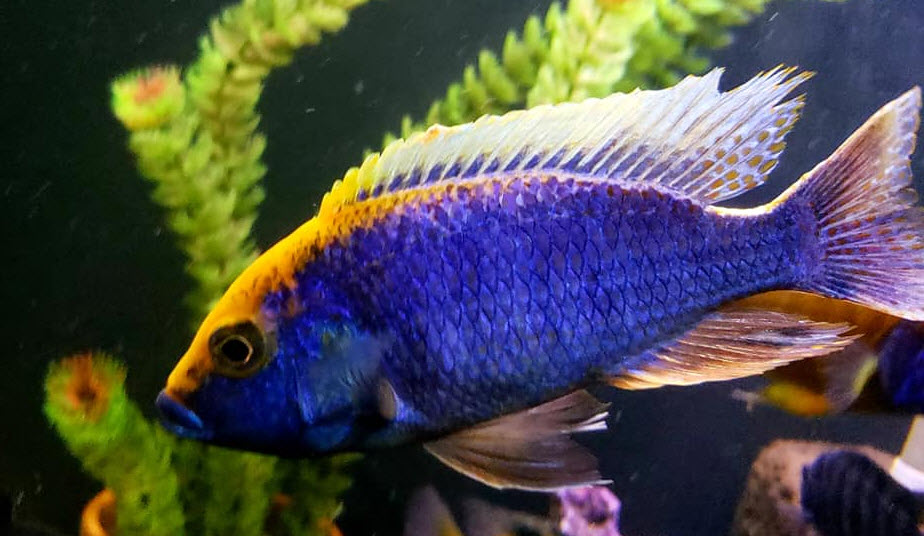
Fluidized Bed Media – Plastic Straws
One little oddity some DIY websites push is ¼ inch cut up sections of plastic straws. This actually is a very good media if one can find a cheap source of plastic straws (NOT Amazon!). I found a package of plastic straws for $1.00 at my local supermarket in the cheap goods section. It works out to 40 cubic inches. This in turn works out to $43 per cubic foot and about $19 per pound of fish filtered.
So if one has the patience to do a lot of cutting (a paper cutter would be useful), one can make a straw fluidized bed media. Just make sure they have a cut length about the same as the diameter of the straw. This homemade media should be very close to K1 in performance. Note I haven’t done any testing so that is an unsupported opinion only.
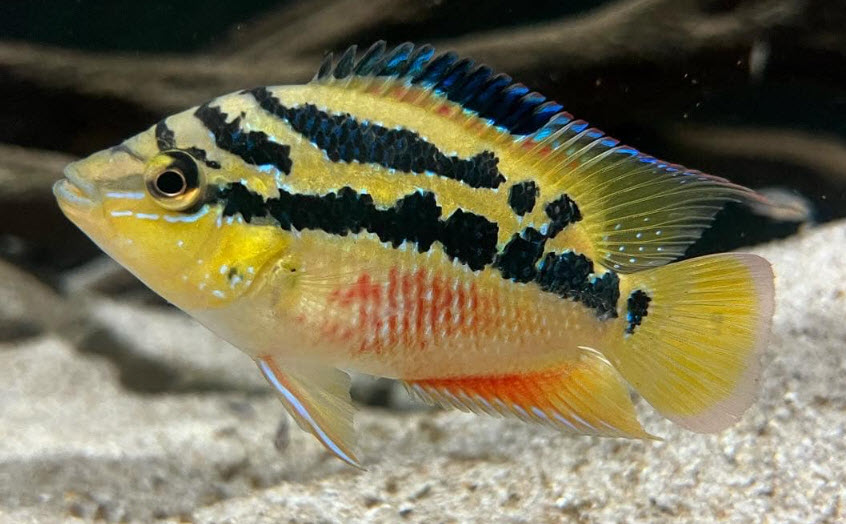
Also note that the whole straws can be used to make some very interesting filtration schemes. For instance, one can pack the baskets in a canister with straws oriented in a vertical position. The flow would be very good and the straws would have a very good surface area. Making and testing such an arrangement is on my “to do” list.
Note that most canisters must have the baskets in the canister in order to operate. The baskets typically have a pipe as part of their construction which shunts the water. This pipe formed by the baskets is integral to the operation of most canisters.
Alternatively a length of 2 inch PVC pipe can be packed with whole straws. The water could be fed to the filter pipe via a tube from a small 3 watt fountain pump. The flow would be down the length of the pipe (and the length of the straws). This would appear to be a very good arrangement for a small nano planted tank. We show several such designs in this link:
8.7.8. Small DIY Filters
.
Return to Filter Media Menu
Return to List of Media Menu
.
Aquarium Science Website
The chapters shown below or on the right side in maroon lead to close to 400 articles on all aspects of keeping a freshwater aquarium. These articles have NO links to profit making sites and are thus unbiased in their recommendations, unlike all the for-profit sites you will find with Google. Bookmark and browse!
.

Luke says
Hi Dave, Evolution Aqua states that their K+ media has got more than twice the amount of protected surface area than their ordinary K1 media (1025 m2 per m3 vs. 500 m2 per m3 respectively). Does this mean that one would only need 160 cubic inches of K+ media in a fluidised bed to get 100 ft2 per ft3 of surface area per 1 lbs of fish? I.e. half of the 320 cubic inches of fluidised K1 listed in your chart?
Dave says
In reply to Wowa. ….. Sounds good to me. That should be plenty of filtration.
Wowa says
Hi Dave
I want to start an 200 l aquarium and a canisterfilter with 24 l k1 Statik and 80 Gramm methabolik Fish. What du you think about it?
Dave says
Sounds about right to me. (0.080 x 0.60)/0.04) = 12 kg
Cecilia says
Hi!
Thank u for this awsome site! I learned so much!
I have a pond with goldfish an koi and want to build a K1 fluidized bed. I do have truble calculating how much k1 i need in kg, cus most that i found sell it in kg.
If i have a 80liter barrel and want 60% k1 in it how many kg do i need to buy?
I found information that 1kg k1 media is 0,004m3.
Is my claculation that i need around 13kg of k1 media correct?
/Cecilia
Aatu L. says
Hi Dave, thank you so much for this article.
I setup my canister filter with bottom tray of sponge and 3 trays of bootleg K1 I got from China, and the water has never been clearer. I also added a pre-filter sponge on the intake.
Previously I had 2 trays of “Micromec” ceramic media. I did the same test as you, breaking one ball open with a hammer. The ball was brown on the outside but completely white and clean inside. It’s true, these things just don’t work.
Dave says
In reply to Yuri ….. I pointedly avoid putting ANYTHING under an undergravel filter. It will interfere with the flow in the UGF.
Yury says
Hi Dave.
How do you like the idea of putting K1 media in the space under the bottom of the Under Gravel Filter (UGF)? This will be a static K1 media in 1 layer and 1 cylinder high (10 mm).
In one of your articles I read that the Under Gravel Filter (UGF) does not require maintenance and can work for many, many years. Therefore, a logical question: will the K1 media, which are located under the bottom of the Under Gravel Filter (UGF), also perform their function for many, many years or will they become clogged after some time and K1 media stop performing their function of biofiltration of the aquarium?
What do you think with your experience and knowledge – How many years Static K1 Media can work without regular cleaning under the Under Gravel Filter (UGF)?
Thank you for your reply and the wonderful scientific articles about aquariums.
Dave says
In reply to Simon …. the whole basket
Simon says
Hello, I would like to use K1 Media as static media in an external filter with four media baskets. The question is how much K1 to pour? The whole basket or maybe half? Best regards
Dave says
In reply to Alex ….. Go ahead and oversize. There is no problems associated with doing that.
I have no problems with using the Aliexpress material. Just be sure to get the Macro density. And I’ve become of the mindset that some form of mechanical filtration is required in a fluidized bed K1 sump.. Either UGF or some foam.
Try 8.5 lbs per cubic foot or 136 grams per liter for the gross density of K1
Alex Sutherland says
Dave thank you for the many useful articles. I have a couple questions. First, is it a problem to grossly oversize a filter setup? I’m setting up a 135 gallon tank for SA cichlids, and my fish are currently juveniles. Their metabolic weight is around 0.5lbs today, but they will eventually grow close to 5 lbs. Would it be reasonable to size my sump for a 5lb load from the start? Or should I plan on increasing the capacity as needed? I worry that it may be difficult to get a large filter cycling with a small bio load.
Second I’m debating between K1 and foam in my sump. I’ve found that 35ppi filter foam is available from Chinese websites (like AliExpress) for about 1/4 the cost of genuine Poret foam. The sellers claim it to be aquarium safe. Would you have any concerns with using this for a foam sump?
Finally it seems that a lot of K1 is being sold by weight. I’m struggling to find a conversion for how much 1kg of K1 equals in liters. It is hard to know how much is required, or to compare costs. Do you know a rough calculation for weight to volume of K1 media?
Dave says
In reply to Jaume ….. I have no idea. I guess I would start in the produce aisle of the grocery store. Onions and oranges would seem to come in suitable bags.
Jaume says
Hello. For both k1 and pot scrubbers, static, in an Eheim classic 150, I’d like to be able to have them in some sort of bag to be able to remove them easily in case I want to occasionally slightly clean them if clogged at some point (if at all necessary at any point). What kind of “bag” would you recommend for this to avoid interfering with the filtration, particularly for k1 as it is small and can slip through holes in the bag?
Thank you
Dave says
In reply to Eddie …. I guarantee you have plenty of clear biofilm on your media.
Eddie says
I made the move to using K1 media. I could not add a sump so i bought a large cylinder “reactor” type filter that can fit over 1 kg of k1. Water circulates quite fast to keep the k1 moving in circles in the cylinder. Now, after 4 months i see that the K1 media still looks very clean with no bio filter that i can see inside individual pellets. I am thinking that these reactor filters can’t be used because the current is too strong, preventing any biofilm to form.
My question is – is the biofilm always visible to the naked eye – i.e. could there be useful biofilm formed even if i can’t see it? Thank you for providing such valuable information on your website David.
Dave says
In reply to Ana …. I don’t sell anything
Ana Fernandes says
Good afternoon,
I need 3000 liters of K1 (KALDNESS)
Do you have it for delivery? How much?
Delivery time?
Best regards
Ana Fernandes
Dave says
In reply to Wayne …. You are at about 50% stocking that my stocking calculators will “recommend” Just do not add anymore fish for several months. Let the tank mature.
Wayne says
Hi Dave, thank you so much for the advice. Will go with the pot scrubbers. Do you consider my tank stocking over the maximum “recommended”?
Dave says
In reply to Wayne and Brad ….. The key to a good canister filter with foam is the cutting of the foam. If the foam doesn’t cover the entire tray quite tightly the water will flow around the foam. Pot scrubbers and K1 don’t seem to have that problem. Personally I’d go with the pot scrubbers packed in as tightly as possible.
Wayne says
Hi Brad, thank you for your suggestion. I agree that 20ppi foam will provide the same bio filtration and better mechanical filtration. But thinking if K1 or pot scrubbers will be sufficient with much lesser filter maintenance required. Btw tank is 20G with about 30 tetras size 1-2 inches. And some amano shrimps 😂
Brad - UK says
@Wayne
I don’t think you’ll get much benefit from using K1 compared to 30PPI foam. In a static configuration, 30PPI foam will be more efficient than K1. (Also, static K1 has the same effective surface area as 20PPI foam.)
If it were me (but please wait for Dave), I would say you are better off filling your filter with all 20PPI or all 30PPI foam. If you have a heavy load, then 20PPI would be better for clogging prevention.
Wayne says
Hi, Dave, I’m going to replace the middle tray of my Fluval 207 with K1. How tight should I ‘cram’ them in there? As for the top tray, should I also use K1 in media bag, pot scrubbers or 30ppi sponge? Aiming for efficiency and minimal filter maintenance. Got easy access to both media.. TIA
Tim says
I created a test print using Cura Gyroid infill with 3mm spaced lines, 0.5mm line width and 0.25mm layer height. Based on the amount of filament Cura estimated, I calculated an area/volume of 412 ft2/ft3, even better than 30ppi foam! Of course it may plug up but the line pitch can easily be tweaked to balance area and aperture. The gyroid infill makes a very open-cell foam like structure though much more regular. The walls are sloped an average 45deg, so gives more area than I think I honeycomb would (honeycomb is not an option in Cura so can’t compare).
However, to fill one Eheim Pro2 filter tray it would take ~12hrs to print and cost ~$10, about the same cost to just buy 3 Eheim coarse foam inserts.
I may throw one in to see how it goes… not super scientific though.
Tim
Tim says
@Justin – I like the idea of a 3D printed layer. We’re always told not to use 3D printed items for food/beverage containers as the layer lines and micropores will harbor bacteria – well this would put that to use!
I wonder if honeycomb is the best? In theory one could create a solid shape in CAD, then tell the slicer to print no top/bottom layer and pick a nice infill pattern to generate the pores. I wonder if there would be any advantage to something more turbulent? I thought I saw something mentioning gyroids for filtering media in tech article – that’s an option for infill in Cura at least.
Tim
Dave says
In reply to Justin ….. Sounds like an excellent idea. I’m not doing anymore testing but If you want to try it I would be interested in how it works.
Justin says
Thanks for all of your awesome articles and research. Your final idea on the straws – getting a set together in the direction of water flow – gave me an idea. You can 3D print a honeycomb grid instead of the straws and use that as a layer in your filter. I think I will design one for my HOB. You can probably get a little more surface area than straws by using thick layer lines too. I could print one for you if you would want to test it.
Anonymous says
Are probably missed it if it was written down, where does the number 540 for effective surface area of k1 in a fluidized bed come from when compared to static k1 media. Does one simple just double the effective surface area of fluidized media when compared to its static counterpart?
Dave says
In reply to Johnathan …. The King of DIY missed the mark on this one. The K1 will be five to ten times more efficient than the ceramic rings.
And for Aquaclear or internal filters I recommend either the precut foam that came with the unit and/or plastic pot scrubbers.
Johnathan G. says
Hi Dave. I’ve seen a video from King of DIY in which he mentioned that a 500ml bottle of K1 media is less effective at biological filtration compared to a 500ml bottle of ceramic rings in a DIY fluidized filter.
Is there any truth to his claim? Additionally, if one has a small aquarium, with a simple filter like an AquaClear or internal filter, what would be your recommendation for filter media to use?
Michael says
Hi Dave, thank you so much for the response and the advise. I am able to source the K1 Micro in smaller quantities such as a liter or 2 from someone who has purchased this media in bulk and is willing to sell it to me close to the price per liter when purchased in bulk. I would assume for a filter such as the one on the Juwel tank, less than 1 liter of K1 Micro should probably be the max I can fit.
Dave says
Michael … keep your sponges, replace the bioballs and ceramic rings with plastic pot scrubbers. K1 media will work in a bag but it is very expensive in small quantities such as you will need, thus I would go with pot scrubbers.
Michael says
Hi David. I’ve been reading your blogs on filter media and learned a lot of things I simply never knew of before. I am a beginner fish keeper and have basic filter setups like the AquaClear 30 for my 60l tank and the Juwel internal filter (which comes with the Juwel 180 tank), which takes baskets. Currently, I am using a mix of course and fine sponges, ceramic rings, and bio balls, which you have proved are pretty useless.
Can I use a mesh bag filled with K1 Micro media in these filters, or is this media only for fluidized beds/sumps and canisters?
Additionally, please can you recommend what filter media would be ideal for the type of filters I have?